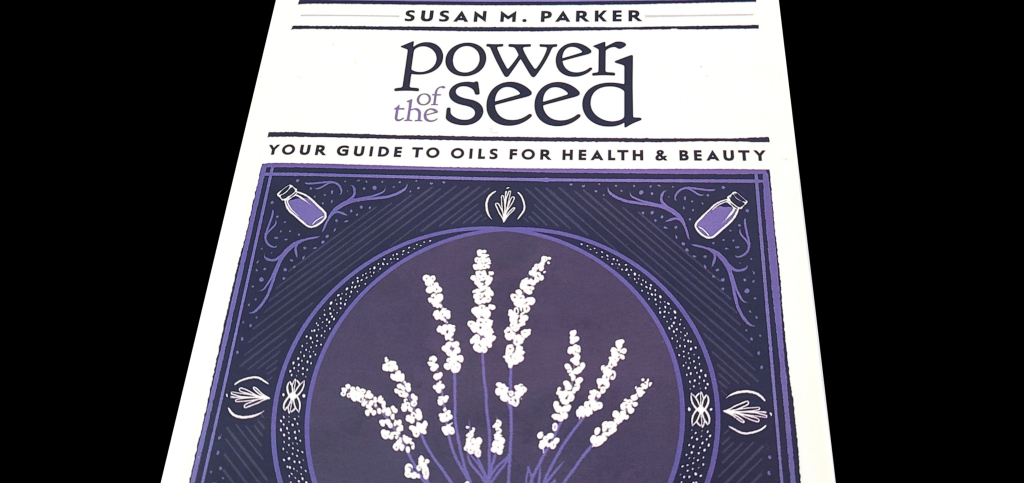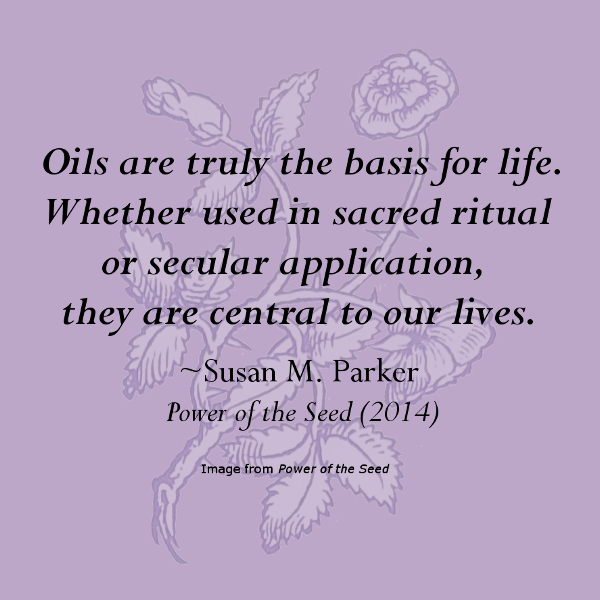
Mom’s Review: Power of the Seed
Susan M. Parker’s Power of the Seed is the first book of its kind. When so much is written about essential oils, Power of the Seed delves deeply into the fixed lipid oils (aka “carrier oils”) that are vital ingredients in skin care, cooking, art, medicine, and industry.
In the world of Aromatherapy, the lipid oils are often given a backstage to essential oils. Perhaps after understanding how powerful these lipid plant carrier oils are, they will be given center stage rights along with the aromatic essential oils.
Power of the Seed should be a well-thumbed reference in every Aromatherapist and Skin Care Formulator’s library.

[This post contains affiliate links. If you make a purchase through one of these links I may earn a commission. This does not impact your price. For more information, please see our disclosure.]
Power of the Seed Origin Story: A Collection of Lipid Oil Profiles

The seeds for this book were sewn by a series of self-published booklets. Susan published them just so that she could have all the material she had collected in one place. These early booklets focused on the chemical makeup and structure of 35 carrier oils.
Years later, Susan began to assemble all she had discovered through many hours of research and actually working with the oils. This collection eventually became Power of the Seed. Those original 35 oils had grown to over 80 carrier oils! And the information she’d accumulated grew from just the chemistry of these lipid oils to color, skin feel, functional properties, and even taste of each oil.
Starting with Lipid Oil Basics
Before jumping into the lipid oil profiles, Susan ensures her readers have a solid understanding of the role lipid plant oils play in skin care. This includes understanding the structure of the skin and how plant oils help support healthy skin.
Power of the Seed takes complex concepts, like how fatty acid composition impacts skin feel and absorption rates and makes them completely understandable.
Susan then goes on to discuss the importance of the non-fatty acid constituents in these oils. While the fatty acids comprise the largest percentage of lipid oils, these other phytochemicals play a vital role in the nourishing aspects of these oils. Called the healing fraction or unsaponifiable fraction, these are the antioxidants, flavonoids, minerals, terpenes, and vitamins.
“(All lipid oils are) made up of two parts. The major component is the lipids, the combinations of fatty acids. A minor but important part comes from plant compounds that give the oils their individuality, color, taste, and scent. Within this simple description lies a complex and vast variety of combinations.”
~Susan M Parker, Power of the Seed (2014)
Profiling the Lipid Oils
The second third of Power of the Seed is dedicated to the profiles of nearly 100 lipid plant oils, butters, and waxes. (Susan also provides profiles of Beeswax and Lanolin.)

The profiles include:
- common name
- botanical name
- INCI (International Nomenclature Cosmetic Ingredient)
- fatty acid profile
- healing fraction components
- skin feel
- function in skin care
- use in soap-making.
In addition to the common lipid oils like Hemp seed, Grapeseed, Sunflower, Safflower, Sesame, and Jojoba oils, Susan includes profiles for some of my favorite lipid oils for skin care:
- Borage seed oil,
- Chia seed oil,
- Evening Primrose seed oil,
- Kukui nut oil,
- Macadamia nut oil,
- Meadowfoam seed oil,
- Passion fruit seed oil,
- Pomegranate seed oil, and
- Tomato seed oil.
Lipid Oils at Work

By the time you get to the final third of the book you’ll be well versed in fatty acid profiles, healing fractions, and how powerful and important these lipid carrier oils are to our formulations. Now it’s time to put those oils to work!
Susan provides simple directions for working with lipid oils to create body butters, facial serums, oil cleansers, massage oils, body scrubs, salves, and herbal infusions. Her recipes provide guidelines that allow you to incorporate the oils that appeal to you.
The Appendices
Sometimes the bits that are tacked onto the end of a book are a wealth of information. This is certainly true for Power of the Seed!
The Appendices include quick reference guides for botanical families and fatty acid families, at-a-glance fatty acid profiles for each lipid oil profiled, and a glossary of terms. For the soap-maker, she includes a chart of saponification values.


Power of the Seed is available on Amazon where it can be purchased as a paperback or Kindle version.
Learn more about Susan Parker and other lipid plant oils on her blog, The Lipid Oils Academy (not an affiliate link).
You can find other books on skin care and aromatherapy in Mom’s Library Favorites on Amazon.
- Title: Power of the Seed
- Author: Susan M. Parker
- Publisher: Process Media (2014)
- Language: English
- Paperback: 336 pages
- ISBN-10: 1934170542
- ISBN-13: 978-1934-17054-0

Chris P | Author, Certified Aromatherapist, Natural Skin Care Formulator
Chris (“Mom”) enjoys formulating bespoke aromatherapy, skin care, and herbal products to support her family, pets, friends, and clients. She also loves experimenting with recipes in the kitchen. An avid reader, writer, and lifetime learner, Chris enthusiastically explores research rabbit holes and then writes about her discoveries.💚 (Learn more >>)



